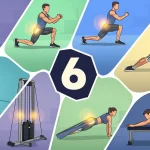Hello, Fit People!
You may have heard about Wall Sit, a simple movement that looks easy but can provide an incredible challenge.
Wall sit is an exercise that doesn’t require any equipment, yet has a significant effect on the lower body muscles.
Let’s discuss what a wall sit is, its benefits, and tips and variations you can try!
What Is a Wall Sit?
Wall Sit, sometimes called Wall Squat, is an isometric core exercise that involves a position like sitting in a chair, but with your back against a wall and without the aid of an actual chair.
This exercise is designed to train your core muscles and strengthen your legs. It can also help you develop better posture.
This exercise is suitable for anyone, whether you’re young or elderly.
You only need to press your back against the wall and bend your knees to form a 90-degree angle, then hold that position for some time. Although it looks easy, wall sit can be a big challenge, especially if held for a long time.
Benefits of Wall Sit
Wall sit offers many benefits, especially for lower body muscle strength and stability. Here are some of the main benefits of this exercise:
1. Increases Leg Strength
Wall sit is very effective in training the main muscles of the lower body such as quadriceps, hamstrings, and glutes. By holding a sitting position without a chair, these muscles work extra hard to keep the body stable.
2. Core Stabilization
This exercise also helps strengthen core muscles, as you need to keep your body position stable while holding the wall sit. This will provide additional benefits for overall body stability and posture.
3. Improves Muscle Endurance
Wall sit is an isometric exercise that focuses on muscle endurance. By holding the position for a long time, you can increase the endurance and strength of your lower body muscles, which will be beneficial in various daily activities and other sports.
4. Easy and Can Be Done Anywhere
One of the advantages of wall sit is its simplicity. You can do it at home, at the gym, or even in the park without needing any equipment. It’s a perfect exercise to do when you don’t have much time or access to a gym.
Tips for Doing Wall Sit Properly
To get maximum benefits from wall sit and prevent injury, here are some tips you need to pay attention to:
1. Correct Knee and Foot Position
Make sure your knees don’t go past your toes when doing a wall sit. Your knees should be aligned with your ankles, forming a 90-degree angle.
2. Back Flat Against the Wall
Your back should be flat against the wall throughout the exercise, especially the lower back. Don’t let there be a gap between your back and the wall to maintain stability and prevent injury.
3. Breathe and Stay Relaxed
During the wall sit, don’t forget to breathe regularly. Holding your breath will make your body tire quickly. Take deep, slow breaths to maintain focus and help hold the position longer.
4. Set a Realistic Duration
Start by holding the wall sit for 20-30 seconds, and increase gradually as your strength and endurance improve. Don’t force yourself to hold too long on the first try.
Wall Sit Variations for More Challenge
If the standard wall sit is too easy for you, try these variations to add challenge:
1. Wall Sit with Leg Raise
After getting into the wall sit position, try lifting one foot a few inches off the floor and hold for a few seconds. Do this alternately. This will add load to the standing leg and increase strength and balance.
2. Wall Sit with Dumbbell or Plate
Hold a dumbbell or weight plate in front of your chest while doing a wall sit to add weight. This will make your muscles work harder and increase the challenge to your leg and core muscles.
3. Wall Sit with Medicine Ball
Place a medicine ball between your knees while doing a wall sit, then squeeze the ball to engage your inner thigh muscles. This is very effective for training inner thigh muscles and increasing stability.
4. Wall Sit Pulses
In the wall sit position, do small up and down movements (about 5-10 cm) to provide additional contraction to the muscles. These pulses provide extra challenge to the quadriceps and help increase muscle endurance.
Conclusion
Wall sit may look like a simple exercise, but its effect is tremendous in increasing leg strength, muscle endurance, and core stability.
This exercise is suitable for all fitness levels and can be done anywhere.
Don’t forget to pay attention to proper technique to get maximum benefits and prevent injury.
If the standard wall sit feels easy, vary your movements to add challenge.
So, Fit People, ready to sit without a chair and burn those leg muscles?
Visit FOCUS FIT, a GYM that can help you improve your fitness and help you achieve your Body Goals!





